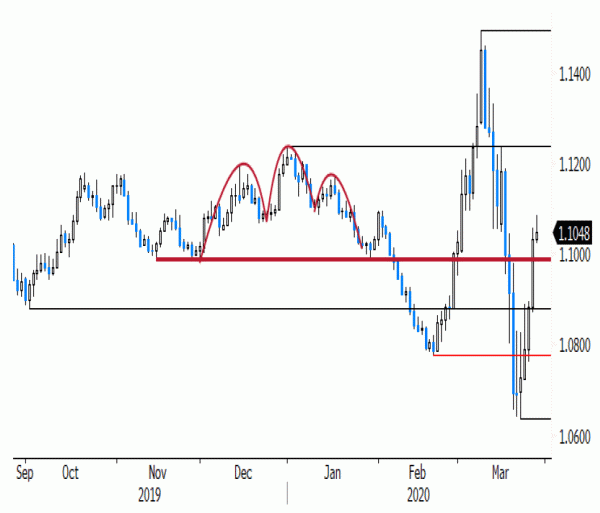- Rates: ECB in control of sovereign spreads
The ECB scrapped the maximum amount of bonds it can buy from each EMU sovereign (issuer limit) to fully employ its €750bn QE bazooka. Peripheral bonds rallied significantly. In combination with the prospect of unlimited OMT-purchases, it indicates that the central bank is de facto in control of sovereign credit spreads. - Currencies: USD ‘long-squeeze’ accelerates
A further easing in stress on global markets triggered a further unwinding of USD safe haven positions. A sharp rise in US jobless claims wasn’t the main factor for the USD decline but also didn’t help the US currency. The swift break of EUR/USD above 1.09 improved the technical picture. Have we entered a USD sell-on-upticks pattern?
The Sunrise Headlines
- US stocks notched their best 3-day rally since the 1930s on more stimulus hopes shrugging off horrible employment data. The Dow Jones outperformed (+6.4%). Asian markets trade rather mixed with Indonesia (+7.9%) taking the lead.
- EU leaders battled to come up with a collective economic response to the coronacrisis and agreed on more time (2w.) to work out a plan. G20 leaders pledged to inject over $5tn into the global economy to limit job/income losses.
- The RBI slashed its policy rate by 75 bps to 4.40% and announced several measures to boost liquidity one day after the government outlined a fresh $23bn round of fiscal stimulus to help the poor hit by the corona outbreak.
- The S&P downgraded Mexico’s credit rating to BBB due to the economic hit from the coronacrisis & plunging oil prices. Fitch affirmed the US’ credit rating at AAA but warned for a near-term negative rating action amid debt piling up.
- UK’s Rishi Sunak announced he agreed with the BoE to widen the scope of the commercial paper facility to not only grant loans to investment-grade companies but construct separate ratings allowing more businesses to benefit.
- Companies are knocking on the doors of fiscal authorities/CBs as they grapple with the blow from the coronacrisis. VW called on the ECB to speed up its plan to buy commercial paper while TUI is close to securing near €2bn in state aid.
- Today’s economic calendar contains secondary, outdated data (e.g. US inflation data for February) that will be waved off by investors. Consumer confidence indicators are due across Europe & Fitch reviews the UK’s sovereign debt rating.
Currencies: USD ‘Long-Squeeze’ Accelerates
Dollar long squeeze accelerates
Yesterday, the broad unwinding of USD long positions continued and accelerated due to multiple drivers. The ample provision of USD liquidity by the Fed both in- and outside the US (swaps) continues doing its job. Global tensions eased (cf. stocks), reducing USD safe haven demand. The trend of declining USD interest rate support continued. The exceptional spike in US jobless claims brought hard evidence of the severe impact of the crisis on the US economy. Claims weren’t the main driver behind the USD correction, but didn’t help either. The trade-weighted USD (DXY) fell below the 100 mark. EUR/USD regained the 1.10 barrier (close 1.1032). USD/JPY closed around 109.30 despite a risk-on context.
This morning, the repositioning out of the dollar continues even as US equity futures suggest that the risk rally might slow. USD/JPY (mid 108 area) declines further. The USD decline is said to be reinforced by yen repatriation flows toward the end of the Japanese fiscal year. Contrary to last week, the Chinese yuan is an ‘underperformer’ with USD/CNY stabilizing in the 7.0750 area. Most other regional FX are also rebounding. EUR/USD (1.1040) maintains yesterday’s gain.
Today, (consumer) confidence data in France and Italy will probably nosedive in an unprecedented way, but are probably no factor for the euro. Yesterday, EU leaders didn’t agree on the (financial) structure of their crisis response. The likes of Germany and The Netherlands still don’t agree on financing on an EU level via coronabonds. This a key political topic for the EU, but as mentioned yesterday, we don’t think that the ESM/OMT option, if it were to be the outcome, should be that negative for the euro. Yesterday and on Wednesday, there were already technical signs of an EUR/USD bottoming. The swift break above 1.09 improves the technical picture. EUR/USD might have entered a buy-on-dips pattern even as end-of quarter repositioning still might cause some nervous swings. 1.1237/50 is a next topside reference.
Yesterday, EUR/GBP initially hovered in the 0.92 area, but the risk-on sentiment and decline of the dollar also caused an aggressive unwinding of sterling shorts. EUR/GBP is now nearing the 0.90 support, which worked as short-term technical reference/bottom during peak period of financial stress. Sterling trading will continued to be dominated by global trends, but maybe the EUR/GBP decline might slow from here.
EUR/USD: USD sell-off accelerates. EUR/USD technical picture improves














